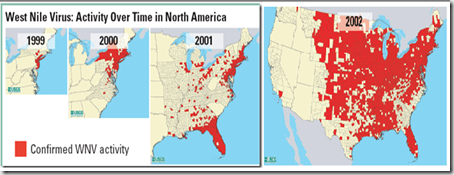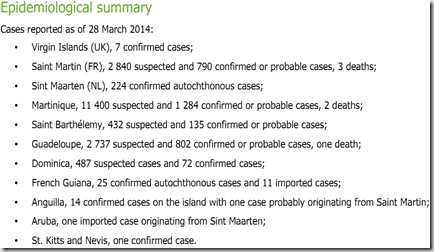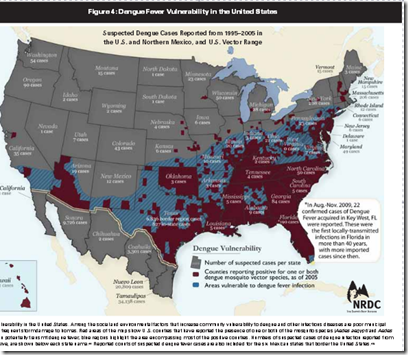Study: Chikungunya?s Growing Threat To The Americas

One of two highly competent vectors in the Americas
# 8443
Up until about a decade ago,Chikungunya (CHKV) - a mosquito-borne virus - was only seen in central Africa. In 2005 it jumped to Reunion Island in the Indian Ocean, where it sparked a major epidemic infecting tens of thousands. Since then it has spread rapidly to counties such as India, Thailand, Vietnam, Indonesia, Myanmar, Pakistan, and others in Asia and the Western Pacific.
First some excerpts from the press release, as link to the study it references, then I?ll be back with a bit more.

In 2009 the Natural Resources Defense Council (NRDC) released a report outlining the risks that Dengue (which relies on the same mosquito vectors as CHIKV) could re-establish itself in North America, that included this map showing the areas of the United States that are vulnerable to the introduction of Dengue. Northern climes are far less likely to see DENV or CHIKV take hold than say, Florida or Southern Texas. Still, in the 18th and 19th century, both Malaria and Yellow Fever were endemic up and down the mid-Atlantic coast.
Perhaps a better example can be found in the West Nile Virus, which arrived in North America in 1997, and over the next five years managed to spread across much of the nation.

From the USGS Factsheet on West Nile Virus
Although West Nile Fever can often be mild, and is grossly underreported, in 2012 the CDC recorded the following statistics on human infection in the United States.

Each summer we keep a close eye on the level of West Nile, EEE, Dengue and other lesser known arboviruses in the United States. This summer, and likely in summers to come, we are going to have to add Chikungunya to that list.
Posted by Michael Coston at <a class="timestamp-link" href="http://afludiary.blogspot.com/2014/04/study-chikungunyas-growing-threat-to.html" rel="bookmark" title="permanent link"><abbr class="published" itemprop="datePublished" title="2014-04-07T14:12:00-04:00">2:12 PM</abbr>

One of two highly competent vectors in the Americas
# 8443
Up until about a decade ago,Chikungunya (CHKV) - a mosquito-borne virus - was only seen in central Africa. In 2005 it jumped to Reunion Island in the Indian Ocean, where it sparked a major epidemic infecting tens of thousands. Since then it has spread rapidly to counties such as India, Thailand, Vietnam, Indonesia, Myanmar, Pakistan, and others in Asia and the Western Pacific.
While rarely fatal, the CDC describes the symptoms of infection as lasting a few days to a few weeks, producing `debilitating illness, most often characterized by fever, headache, fatigue, nausea, vomiting, muscle pain, rash, and joint pain?, although some may experience `incapacitating joint pain, or arthritis which may last for weeks or months.?
Last fall Chikungunya arrived in the Caribbean on the French part of St. Martins ? but quickly spread to other islands in the Leeward and Windward chains - and has now appeared on the South American continent. This from the latestECDCCommunicable Disease Threats Update:Today, the American Society for Microbiology has published a press release warning that next month?s FIFA World Cup in Brazil, along with the presence of two very competent vectors (Aedes Aegypti & Aedes Albopictus mosquitoes) could help put the Chikungunya virus on a fast track to spreading across the Americas. First some excerpts from the press release, as link to the study it references, then I?ll be back with a bit more.
7-Apr-2014
American Society for Microbiology
Chikungunya poised to invade the Americas
A team of French and Brazilian researchers warn that chikungunya virus is poised to invade, and become epidemic in the Americas according to research published ahead of print in the Journal of Virology.
The risk of a "catastrophic" epidemic in the Americas is boosted by the FIFA World Cup, to be held in Brazil next month, what with people coming in from near and from far, says corresponding author Ricardo Lourenco-de-Oliveira of the Instituto Oswaldo Cruz in Rio de Janeiro, Brazil. Brazil annually reports the highest incidence of dengue, a virus that is transmitted by Aedes aegypti and Aedes albopictus, the same mosquitoes that transmit chikungunya, he says.
The basis of his worries is the study, in which he and his collaborators compared the ability of 35 populations of the two Aedes species to transmit three different genotypes of chikungunya. These populations ranged all over the Americas from Buenos Aires to Tyson, Missouri (near St. Louis.) Even in temperate Missouri, A. albopictus was found to have a high dissemination and transmission ability for two of the three chikungunya genotypes.
(Continue . . . )
The study, which this press release references was published ahead of print in the online version of the Journal of Virology late last month. American Society for Microbiology
Chikungunya poised to invade the Americas
A team of French and Brazilian researchers warn that chikungunya virus is poised to invade, and become epidemic in the Americas according to research published ahead of print in the Journal of Virology.
The risk of a "catastrophic" epidemic in the Americas is boosted by the FIFA World Cup, to be held in Brazil next month, what with people coming in from near and from far, says corresponding author Ricardo Lourenco-de-Oliveira of the Instituto Oswaldo Cruz in Rio de Janeiro, Brazil. Brazil annually reports the highest incidence of dengue, a virus that is transmitted by Aedes aegypti and Aedes albopictus, the same mosquitoes that transmit chikungunya, he says.
The basis of his worries is the study, in which he and his collaborators compared the ability of 35 populations of the two Aedes species to transmit three different genotypes of chikungunya. These populations ranged all over the Americas from Buenos Aires to Tyson, Missouri (near St. Louis.) Even in temperate Missouri, A. albopictus was found to have a high dissemination and transmission ability for two of the three chikungunya genotypes.
(Continue . . . )
High vector competence of Aedes aegypti and Aedes albopictus from ten American countries as a crucial factor of the spread of Chikungunya
Anubis Vega-R?aa,b, Karima Zouachea, Romain Girodc, Anna-Bella Faillouxa* and Ricardo Louren?o-de-Oliveiraa,d*
IMPORTANCE Until recently, the Americas have never reported chikungunya (CHIK) autochthonous transmission despite its global expansion beginning in 2004. Large regions of the continent are highly infested with Ae. aegypti and Ae. albopictus and millions of dengue (DEN) cases are annually recorded. Indeed, DEN and CHIK viruses share the same vectors. Due to a recent CHIK outbreak affecting Caribbean islands, the need for a Pan-American evaluation of vector competence was compelling as a key parameter in assessing the epidemic risk. We demonstrated for the first time that Ae. aegypti and Ae. albopictus populations throughout the continent are highly competent to transmit CHIK irrespective to the viral genotypes tested. The risk of CHIK spreading throughout the tropical, subtropical and even temperate regions of the Americas is more than ever a reality. In light of our results, local authorities should immediately pursue and reinforce epidemiological and entomological surveillance to avoid a severe epidemic.
(Continue . . . )
Although the Aedes Aegypti mosquito is pretty much limited to the Gulf Coast states, the relatively recent introduction and growing geographic range of the Aedes Albopictus mosquito (see below) has raised concerns that once eradicated tropical diseases could become endemic across much of the US once more.Anubis Vega-R?aa,b, Karima Zouachea, Romain Girodc, Anna-Bella Faillouxa* and Ricardo Louren?o-de-Oliveiraa,d*
IMPORTANCE Until recently, the Americas have never reported chikungunya (CHIK) autochthonous transmission despite its global expansion beginning in 2004. Large regions of the continent are highly infested with Ae. aegypti and Ae. albopictus and millions of dengue (DEN) cases are annually recorded. Indeed, DEN and CHIK viruses share the same vectors. Due to a recent CHIK outbreak affecting Caribbean islands, the need for a Pan-American evaluation of vector competence was compelling as a key parameter in assessing the epidemic risk. We demonstrated for the first time that Ae. aegypti and Ae. albopictus populations throughout the continent are highly competent to transmit CHIK irrespective to the viral genotypes tested. The risk of CHIK spreading throughout the tropical, subtropical and even temperate regions of the Americas is more than ever a reality. In light of our results, local authorities should immediately pursue and reinforce epidemiological and entomological surveillance to avoid a severe epidemic.
(Continue . . . )

In 2009 the Natural Resources Defense Council (NRDC) released a report outlining the risks that Dengue (which relies on the same mosquito vectors as CHIKV) could re-establish itself in North America, that included this map showing the areas of the United States that are vulnerable to the introduction of Dengue. Northern climes are far less likely to see DENV or CHIKV take hold than say, Florida or Southern Texas. Still, in the 18th and 19th century, both Malaria and Yellow Fever were endemic up and down the mid-Atlantic coast.
After an absence of 6 decades, Florida has reported sporadic locally acquired dengue cases over the past four years (see Florida: Dengue Forces Suspension Of Blood Donations In Two Counties), and just last year New York City reported a locally acquired case.
Perhaps a better example can be found in the West Nile Virus, which arrived in North America in 1997, and over the next five years managed to spread across much of the nation.

From the USGS Factsheet on West Nile Virus
Although West Nile Fever can often be mild, and is grossly underreported, in 2012 the CDC recorded the following statistics on human infection in the United States.
Final 2012 West Nile virus update:
In 2012, all 48 contiguous states, the District of Columbia, and Puerto Rico reported West Nile virus infections in people, birds, or mosquitoes. A total of 5,674 cases of West Nile virus disease in people, including 286 deaths, were reported to CDC. Of these, 2,873 (51%) were classified as neuroinvasive disease (such as meningitis or encephalitis) and 2,801 (49%) were classified as non-neuroinvasive disease. The numbers of neuroinvasive, non-neuroinvasive, and total West Nile virus disease cases reported in 2012 are the highest since 2003.

With summer temperatures rising across much of the United States, mosquito season cannot be far behind. So, if you live in, or are visiting one of these areas, many health departments urge you to follow the `5 D?s?. In 2012, all 48 contiguous states, the District of Columbia, and Puerto Rico reported West Nile virus infections in people, birds, or mosquitoes. A total of 5,674 cases of West Nile virus disease in people, including 286 deaths, were reported to CDC. Of these, 2,873 (51%) were classified as neuroinvasive disease (such as meningitis or encephalitis) and 2,801 (49%) were classified as non-neuroinvasive disease. The numbers of neuroinvasive, non-neuroinvasive, and total West Nile virus disease cases reported in 2012 are the highest since 2003.


Each summer we keep a close eye on the level of West Nile, EEE, Dengue and other lesser known arboviruses in the United States. This summer, and likely in summers to come, we are going to have to add Chikungunya to that list.
Posted by Michael Coston at <a class="timestamp-link" href="http://afludiary.blogspot.com/2014/04/study-chikungunyas-growing-threat-to.html" rel="bookmark" title="permanent link"><abbr class="published" itemprop="datePublished" title="2014-04-07T14:12:00-04:00">2:12 PM</abbr>

